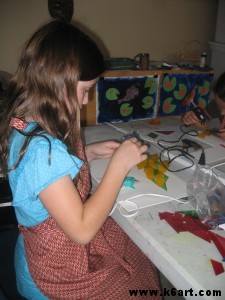Are you thinking about running an art camp this summer? For three summers, I ran a small art camp for kids entering grades 1-6. It was a great way to earn extra money. But there are some practical issues you need to think about.
Money:
How much should I charge? Obviously, you need to see what others are charging in your area. I charged $175 for a 5 day session, at 3 hours/day. The price included all supplies and a snack.
Here are some questions the parents asked me:
- Do you have a day rate?
- Can we go to camp M,W,F only?
- Can we bring a cousin who is visiting for a day?
- Can I have a refund if my kid gets sick?
Think about prorating. And think about which projects you will offer – can they be done (and dry?) in a day?
Are you going to ask parents to put down a deposit to hold their space? (You could ask for a check, and then not cash that check until the first day of camp).
Record keeping:
I kept good financial records. I set up a special checking account and got a debit card associated with it so I could keep my camp finances separate from my home finances.
Are you going to declare your proceeds on your taxes? You are supposed to (at least here in the U.S.). I did declare my earnings, and was surprised that I had to pay not just federal and state taxes, but a self-employment tax when I went solo. Run your art camp ideas past your accountant before you start planning – it may save you some headaches next April.
I once offered my camp at the local community center. They had a ‘split’ – I think it was 60%/40%. They collected the money. They paid me, and withheld taxes.
Where to hold camp?
I held camp in my garage and back yard, with trips to the playground down the street. I once held a short camp at our community center. I have even seen an artist hold camp at a local park: she put a shade structure over a picnic table, and set up shop right there. My colleague once rented out studio space in the back of a gallery, with ‘recess’ at the adjacent park.
No matter what camp you offer, and where you offer it, you need to think about safety and liability.
Safety:
At minimum, you need a first aid kit. If you work for a school district you may have already had CPR or first aid training. If not, you may want to brush up on your first aid. You need to know the kids food and insect allergies. I asked parents to send their kids with hats and sunscreen so we could stay outside if we wished.
Liability:
I bought camp insurance from this company. Price varies according to how many kids you have. Because I held camp in my own home, I added an umbrella policy to my homeowner’s insurance.
I had parents fill out a camp health and emergency form (you do want to know about allergies/meds). There is a ‘hold harmless’ section on this form…think about putting some sort of hold harmless language on your forms.
Ratios:
My ratio was 1:8. I sometimes had a teenage helper – then I could accept 10-12 kids instead of 8. Think about the minimum number of sign ups you need to make it worth your while to hold camp. Teenage helpers are great (p.s. if you know any teens, they could set up their own art camp and do crafts with neighborhood kids this summer).
Hours of operation:
I had one a.m. session from 9-12, and a p.m. session from 12:30 – 3:30. The first and last 15 minutes were open to free draw, books and art games as kids did not all arrive on time. We worked about an hour, took a break, and then worked a second hour.
Here are some issues that (occasionally) came up:
- Parents dropped off kids too early
- Parents picked up kids too late
- The 30 minute break between sessions was too short for me.
Good luck! I hope you have a fun summer.
This is part 3 in the art camp series. The other parts are polymer clay projects and shrinky dinks projects.

